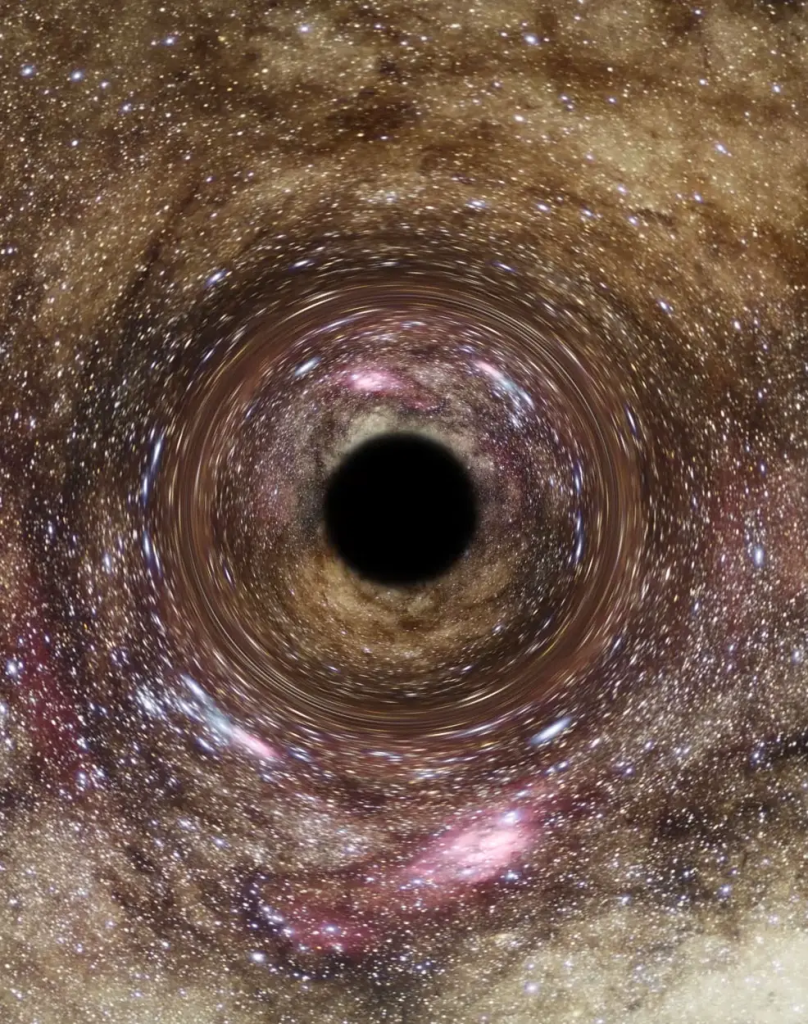Astronomers in the UK have identified an “ultramassive” black hole – one of the largest ever discovered – and the first to be confirmed through gravitational lensing, at the centre of the galaxy Abell 1201 BCG.

Gravitational lensing occurs when a foreground galaxy bends light from a more distant background object and magnifies it. A team led by Durham University in the UK has taken advantage of this phenomenon, combined with supercomputer simulations, to reveal a monster black hole.
The object, Abell 1201, is located about 2.7 billion light years away in the constellation Leo and contains an estimated 32.7 billion solar masses. This places it close to the theoretical maximum of 50 billion solar masses that current models predict (given the age of the Universe, and the available matter, there is simply not enough time for black holes to grow any larger than that).
While reviewing images from a galaxy survey, Durham University’s Professor Alastair Edge noticed the giant “arc” of a gravitational lens. He and his colleagues obtained extremely high-resolution images from the Hubble Space Telescope and then performed a more detailed analysis using the DiRAC COSMA8 supercomputer facilities at the university.
Their study involved simulated light travelling through the Universe hundreds of thousands of times. Each simulation included a different mass black hole, changing the light’s journey to Earth. When the researchers included an ultramassive black hole in one of their simulations, the path taken by light from the faraway galaxy matched the path seen in real images captured by the Hubble Space Telescope. Abell 1201 is the first black hole found using this technique.
“Most of the biggest black holes that we know about are in an ‘active’ state, where matter pulled in close to the black hole heats up and releases energy in the form of light, X-rays, and other radiation,” said Dr James Nightingale, Department of Physics. “However, gravitational lensing makes it possible to study inactive black holes, something not currently possible in distant galaxies. This approach could let us detect many more black holes beyond our local universe and reveal how these exotic objects evolved further back in cosmic time.”
The sheer scale of Abell 1201 is almost beyond comprehension. To understand it, we need to look at the different classes of these objects. A common or garden “stellar” black hole typically weighs in at between five and several tens of Sun masses. The class above that is “intermediate” and has a wider range of masses, from 100 to about 100,000 times that of our Sun. The rarest type is “supermassive” black holes, which are believed to form at the centre of most galaxies and includes Sagittarius A* in the Milky Way. These are hundreds of thousands to billions of solar masses.
An even larger class, known as “ultramassive“, has been proposed for objects of 5 billion solar masses or more. These are exceedingly rare, with only a few dozen known throughout the Universe. Abell 1201 falls into that category and is the 6th most massive found to date, excluding two larger candidates with potentially unreliable measurements.
“This particular black hole, which is over 30 billion times the mass of our Sun, is one of the biggest ever detected and on the upper limit of how large we believe black holes can theoretically become, so it is an extremely exciting discovery,” added Nightingale.
For comparison, Sagittarius A* in the Milky Way is “only” 4.3 million solar masses, four orders of magnitude smaller. Even the colossal black hole in M87 – one of the largest galaxies in the local Universe – is dwarfed by Abell 1201, at just one-fifth of its mass.
For an even more mind-blowing perspective, consider this. If placed in the centre of our own Solar System, Abell 1201 would stretch beyond Pluto’s orbit and continue outward, about six times further than the current location of the Voyager 1 spacecraft. We can calculate the Schwarzschild radius – its outer perimeter from which nothing can escape, even light – at 96 billion kilometres, or 645 astronomical units (AU). This is so large, in fact, that it covers about one-third of the distance to the hypothetical Oort cloud, as shown in the diagram below (click for larger version).
This new study of Abell 1201, which included Germany’s Max Planck Institute, opens up the tantalising possibility that future large-scale telescopes could find many more inactive and ultramassive black holes than previously thought, perhaps at even greater distances.
The findings appear this week in the journal Monthly Notices of the Royal Astronomical Society.







